TimeLine : The Making of Star Wars
Star Wars: 1944-1974 . 1975 . 1976 . 1977The Empire Strikes Back: 1978 . 1979 . 1980
Return of the Jedi: 1981 . 1982 . 1983
Credits
- George Lucas begins meeting with Philip Kaufman to flesh out a rough story idea for The Adventures of Indiana Smith. Due to Kaufman's other obligations, the project had to be shelved. (It would of course later become Raiders of the Lost Ark.)
- Marcia Lucas is hired to edit Martin Scorses's Taxi Driver.
January 28, 1975
- George Lucas completes a second draft of The Star Wars, now entitled Episode One in The Adventures of the Starkiller, which had taken him nine months to write. It was here that Lucas began to transform the Jedi-Bendu into a supernatural knight that draws their power from "The Force." The Dark side of the Force is known as the Bogan, while the Light side of the Force is known as the Ashla. The Death Star becomes a giant space station capable of destroying planet. "The Starkiller" is a wrinkled, old man - hundreds of years old, with 12 children. Starkiller is the master Jedi and is thought by many to be long dead. The young character of Annikin is renamed Luke Starkiller, and became a farm boy that was also "an aspiring archaeologist." The character of Darth Vader is now a seven-foot tall Black Knight of the Sith, complete with black robes and a breathing mask. Jedi Darklighter is mentioned as being a Jedi student that abandoned his training early and became a Sith. Vader, who serves the Prince Espaa Valorum, also engages in a duel with Deak Starkiller aboard a spaceship. Lucas also began to flesh out more of the backstory about the creation of the Empire. Wookiees began to evolved, with inspiration from Lucas' Alaskan Malamute Indiana, into something more closely resembling the final character seen in the film.
The story involved Starkiller's sons Deak and Clieg heading to Utapau to meet up with their brother Luke in a quest to find the Kiber-Crystal, which can be used to strengthen the powers given by "The Force." Lord Darth Vader boards the sons ship and engages in a "Laser Sword" duel with Deak. Clieg is killed in the battle with Vader's stormtroopers. Vader orders an attack on the planet of Ogana Major. Artoo Detoo and See Threepio escape the planet and find Luke on Utapau. "Grey Tusken" soldiers are mentioned as working for the Empire to track down the droids. After enountering some "Jawa" scavengers, the two robots meet up with Luke and his younger twin brothers Biggs and Windy. Luke's Uncle Owen Lars and Aunt Beru also make an appearance. In this story, Owen takes on more of a "teacher" role and, while not a Jedi-Bendu himself, is said to have trained Luke to fight with the "Laser Sword." Owen tells Luke that he must find his father to teach him "the ways of the Spirit." Luke takes the Kiber Crystal and the two robots and heads to the spaceport at Mos Eisley in hopes of finding transportation to find his father. After a brief battle with drunken creatures in the cantina, Luke meets Han Solo and Chewbacca, the "Wookiee" creature. Solo, who is actually only a cabin boy, fakes a reactor failure aboard his Captain Oxus's ship. Captain Oxus, and crewman Jabba the Hutt, flee the ship allowing Han to leave Mos Esiley with his science officer Montross Holdaack, Luke and the droids.
Upon reaching Ogana Major, they discover that the planet has been destroyed. Luke, believing that his father is dead, informs Han that they must rescue Luke's brother Deak from the Imperial dungeons of Alderaan in order for Han to be paid for his journey. On their approach to Alderaan, the team hides in secret compartments as the ship is caught in a tractor beam. While stormtroopers are searching the ship, Han and Luke fight two of the troopers and steal their uniforms. The two men dressed as troopers (and Chewbacca, posing as a prisoner) find the imprisoned Deak in the detention area of the Imperial base. As Chewbacca carries Deak back to the ship, Han and Luke are discovered by Sith Knights. In order to escape, Han and Luke jump down a garbage chute, where they are soon about to be crushed. After being rescued by the droids, the team returns to the ship and blasts off into space. Luke uses the Kiber Crystal to heal his injured brother Deak and hears the voice of his father in his head, who tells him to come to the fourth moon of Yavin. When the group arrives on the moon of Yavin, Luke meets his father The Starkiller, who informs Luke that the "Death Star," which destroyed Ogana Major, is quickly approaching the planet of Yavin. Luke decides to attack the Death Star, while Han and Chewbacca leave to return home. One Rebel fighter that took part in the battle against the Death Star is known as "Banta One." Father Starkiller uses the Kiber Crystal to fight the Bogan, which alerts Darth Vader of his presence. As Vader is about to destroy Luke's ship, he is attacked by Han and Chewbacca, who decided to return to help their friends. Luke's gunners Threepio and Bail Antilles manage to hit the space station at its weakest point and it explodes.
This draft ends with a teaser for a sequel that would find the group searching for the lost "Princess of Ondos."
January 31, 1975
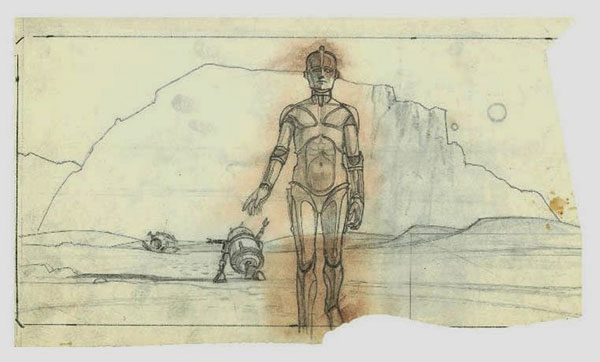
- Ralph McQuarrie finishes his first painting based on The Star Wars story. This first painting, entitled "Artoo and Threepio leave the pod in the desert," featured the two droid characters wandering through the desert of Utapau. Immediately, McQuarrie's paintings began to have an affect on the frequently changing script.
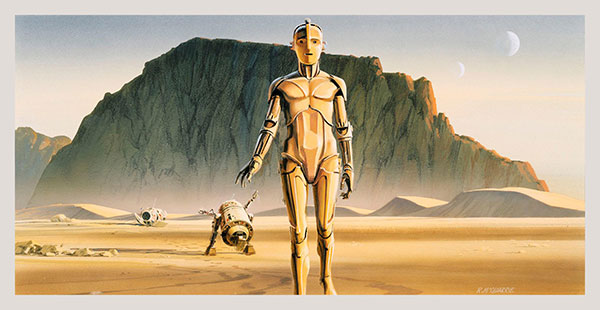 McQaurrie's concept paintings became crucial to the ongoing budget talks with 20th Century Fox. It was difficult for the company to talk about a budget when no one had any idea what the film was going to look like. Add to that the confusion over Lucas' dramatically changing script and the studio needed something visual to solidify their understanding of what the film was really about.
McQaurrie's concept paintings became crucial to the ongoing budget talks with 20th Century Fox. It was difficult for the company to talk about a budget when no one had any idea what the film was going to look like. Add to that the confusion over Lucas' dramatically changing script and the studio needed something visual to solidify their understanding of what the film was really about.
February 14-15, 1975
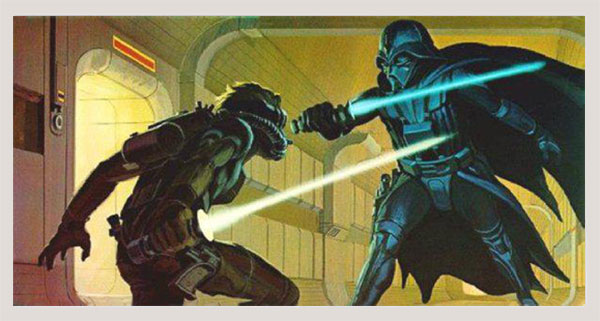
- In one day, Ralph McQuarrie completes a second painting based on a scene described in the second draft of The Star Wars entitled "Laser Duel."
Ralph McQuarrie: "Early in the script, there was a description of Vader crossing between two ships in space so I created this mask so he could breathe in space, with a suggestion of teeth in the masks grillwork."
Ralph McQuarrie: "George came along in about a week with a little bundle of stuff he'd gotten out of old science-fiction magazines of the 1930s and material like that. George also supplied some books on Japanese medieval stuff... George had mentioned him having to wear a helmet like a Japanese medieval warrior, one of those big flared-out helmets, and I made it somewhere between that and a German World War II helmet. In probably one day, I made all the drawings that pretty much defined Darth Vader. I was moving very fast and didn't have all week to fool around with Darth Vader - I had lots of other things to work on... [George] was very happy if you came up with some ideas that were completely different. George didn't envision Darth Vader with a mask - he said he might have his face covered with black silk. But I got worried for Vader's health, because he has to transfer to another spacecraft through outer space with stormtroopers who had armored space suits... George said, "Well, all right, give him some kind of breath mask," - which he wore through all three films." (Source: Star Wars Insider)
Mid February 1975
- Lucas hires artist Alex Tavoularis to draw storyboards for the opening sequences of the film. Lucas met Tavoularis through Francis Ford Coppola.
February 20, 1975
- Ralph McQuarrie completes the concept painting entitled "Imperial City, Alderaan - city floats in gray clouds."
February 22, 1975
- Ralph McQuarrie completes the concept painting entitled "Battle for Death Star (fighters dive on sphere." The painting shows a Y-Wing attacking the space station.
March 6, 1975
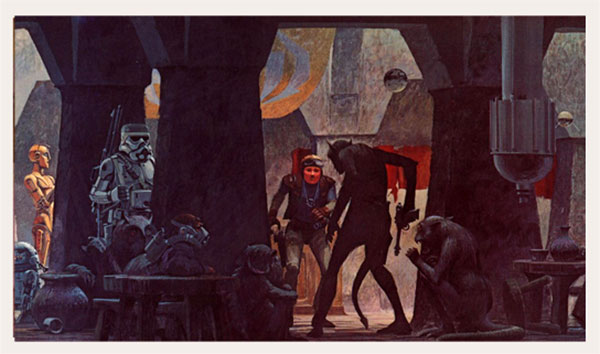
- Ralph McQuarrie completes "Cantina," a concept painting that included an early version of the Stormtrooper.
March 1975
- For a time, the character of Luke Starkiller becomes a, 18-year old female.
March 28, 1975
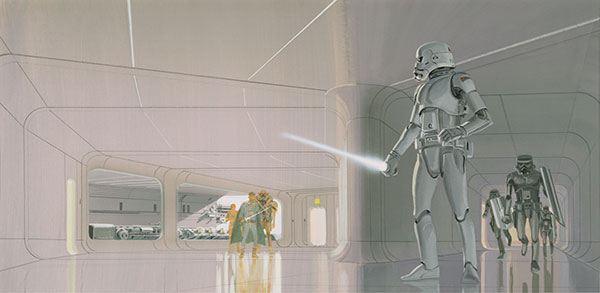
- Ralph McQuarrie completes a concept painting of "Imperial Troopers in Death Star Corridor." The painting shows the heroes of the story, rescuing Deak from the cloud city prison of Alderaan, coming around a corner and approaching a storm trooper with a laser sword. At this time in development, laser swords (later known as lightsabers) were not only used by Jedi Knights.
March - April 1975
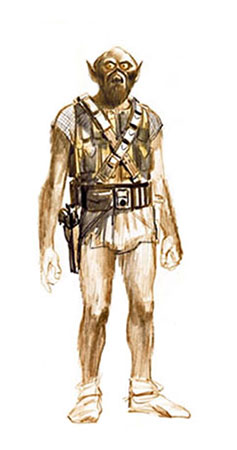
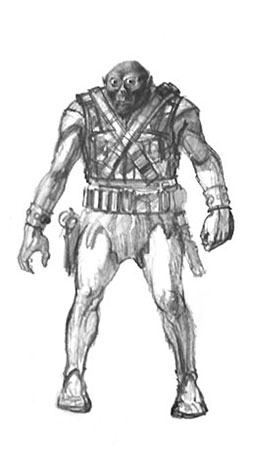
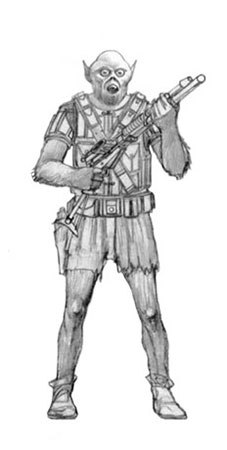
- Ralph McQuarrie creates a few concept sketches for the character of Chewbacca based on early descriptions of the character from the script.
"CHEWBACCA, an eight foot tall, savage-looking creature resembling a huge gray bush-baby monkey with fierce baboon-like fangs. His large yellow eyes dominate a fur-covered face and soften his otherwise awesome appearance. Over his matted, furry body, he wears two chrome bandoliers, a flak jacket painted in a bizarre camouflage pattern, brown cloth shorts, and little else. He is a two-hundred-year-old 'WOOKIEE', and a sight to behold. Han speaks to the Wookiee in his own language, which is little more than a series of grunts."
March 31, 1975
- Ralph McQuarrie completes a concept painting of "Pirate Ship in Alderaan Docking Bay." The painting shows the original Cantwell Pirate Ship in the docking bay of the cloud city prison of Alderaan.
April 1, 1975
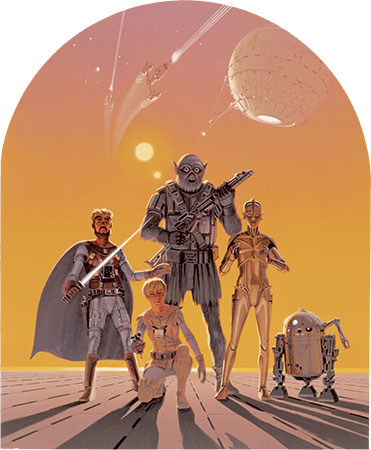
- A Ralph McQuarrie poster design of the main characters shows the newly imagined female lead.
April 3, 1975
- Ralph McQuarrie creates the concept painting for Yavin's "Rebel Space Base (fighters on fourth moon, outside temple hideout."
April 5, 1975
- Ralph McQuarrie creates new sketches and a painting of the Jawa Sandcrawler, based on Joe Johnston's sketches completely re-imagining Colin Cantwell's earlier design.
- Gary Kurtz travels to London around this time to interview potential department heads. Lucas joins him soon after to interview cameramen and art directors.
April 1975
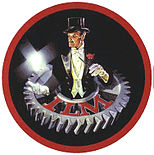
- When FOX shuts down its special effects department, George Lucas begins speaking with John Dykstra about starting up their own special effects company.
Spring 1975
- Lucas meets with composer John Williams through Steven Spielberg. Williams had been working on Spielberg's Jaws. Williams was given a copy of the Star Wars script.
- Gary Kurtz travels to the Florida Everglades with Francis Ford Coppola scouting locations for the film's jungle planet. Coppola was scouting locations to portray Viet Nam in Apocalypse Now.
- Gary Kurtz travels to Olympic National Forest in Washington scouting locations. This location would be rejected due to the restrictions of shooting in a National Park.
Mid 1975
- Lucas director friends continue to read and give input on the early drafts.
George Lucas: "Francis (Ford Coppola) had read the script and given me his ideas, Steven Spielberg had read the script. All of my friends had read the script. Everybody who had read the script gave their input about what they thought was good, or bad, or indifferent; what worked, what didn't - and what was confusing. Matt (Robins) and Hal (Barwood) thought the first half hour of the film would be better if Luke was intercut with the robots, so I did that." (Source: Making of Star Wars)
May 1, 1975
- George Lucas writes a six page synopsis, entitled The Adventures of Luke Starkiller - Episode one: The Star Wars, for Alan Ladd Jr. and the other executives at Fox.
In some ways, this was a summation of the second draft of the story, with several notable changes. The biggest change is the re-introduction of Princess Leia, as the damsel-in-distress that must be rescued, a familiar storyline in the serials and fairy tales that Lucas loved as a child. "The Starkiller" becomes a character of legend that was killed off long before our new story begins. With Leia back in the story, the character of Luke Starkiller also switches back to being a young boy. It was here that the idea of both characters being twins first emerged, since the two characters were essentially developed out of one. Around this same time, Lucas also begins compiling pages of typed notes that included an early version of Ben Kenobi, then known only as the "Old Man."
- Gary Kurtz meets with Robert Watts as a potential production supervisor.
June 1, 1975
- Industrial Light & Magic officially opens at its 6842 Valjean Avenue, Van Nuys, CA. location. Dykstra had found the empty warehouse, which was closer to Hollywood than San Francisco, where Lucas had wanted to locate the new effects company.
The first person hired by ILM was model builder Grant McCune. Hired soon after were Jerry Greenwood, Richard Alexander, Bob Shepherd as production manager, Al Miller, Don Trumbull, model builders Bill and Jamie Shourt, and Richard Edlund, who headed up the camera department.
One of the first projects developed by the fledgling effects company was the design and construction of a motion control camera, which would allow Dykstra and his team to program camera movements and repeat them repeatedly.
Fox had given Lucas a $1.5 million effects budget, instead of the originally proposed $2.3 million. By contrast, the effects shots for the film 2001 cost producers $6.5 million in 1967.
June - December 1975
- ILM's Motion Control camera is built at a cost of around $60,000. This technology, which was pioneered by ILM, allowed filmmakers to program camera movements into a computer while filming stationary models - giving the illusion of movement.
June 11, 1975
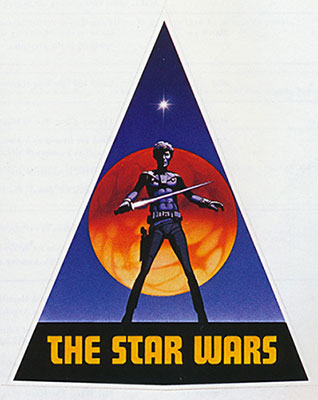
- Ralph McQuarrie designs a logo for Star Wars. Lucasfilm would use this logo on Tshirts, patches, stationary and many other items during production.
Mid June 1975
- Alex Tavoularis finishes his time creating storyboards for the film project. Joe Johnston continue where Tavoularis left off.
June 30, 1975
- It is reported in Daily Variety that principal photography on Star Wars would begin in January 1976 with an expected release date set for the following Christmas. Unfortunately, the film went into limbo with the film studio and delayed production.
July 1975
- ILM hires Robbie Blalack and Adam Beckett to head up the optical department in the lower level of the 12,000 square-foot warehouse. The lower level was to also include two optical printers, a rotoscope department, two filming stages, the model shop, a machine shop, a wood shop and various offices.
The smaller second floor was planned to include the animation, editorial and art departments along with a screening room.
- Ben Burtt is hired through USC to head up the sound department. He immediately starts collecting sounds of animals and other things with equipment from Zoetrope.
Ben Burtt: "In the early stages I spent a lot of time hunting down animal recordings. I listened to all the various material I could get out of libraries in town, and all the various studios. Occidental College has a huge collection of bird sounds from around the world. I went there and spent several days listening to everything they had. But we wanted the sounds to be original, so I also rented animals; I went to people that trained animals for movies, who have ranches, who have bears and elephants and camels. I'd go out in the desert where it was quiet and stand around with the recorders." (Source: Rinzler, The Making of Star Wars. LucasBooks.)
- Grace Kelly, the Princess of Monaco, is named to the FOX Board of Directors.
July 4, 1975
- George Lucas and Gary Kurtz travel to Mexco City to visit the Huycks on the set of Lucky Lady. Lucas continued earlier conversations with the films cameraman Geoffrey Unsworth and production designer John Barry. Both men would eventually agree to join the production of Star Wars. Also hired on the trip was set decorator Roger Christian.
July 24 - August 29, 1975
- Ralph McQuarrie begins working on costume designs, creating sketches of General Ben Kenobi, Sand People and other characters.
August 1, 1975
- George Lucas completes the third draft of The Star Wars : From the Adventures of Luke Starkiller in seven months. By the time of the third draft, Lucas introduces a more defined character of "The Old Man," now known as Ben Kenobi, as the mentor to Luke Starkiller. It is clear that Lucas saw Kenobi as a "Gandalf"-type character, even lifting lines directly from J.R.R. Tolkien's The Hobbit in this third draft. Han Solo is no longer just a cabin boy, but now a full-fledged space pirate. Annikin is mentioned as Luke's father, who was killed in the battle of Condaw, and Kenobi was Annikin's "Commander of the White Legions." At this point, Luke knew his father when he was a child - something that would not disappear from the story until the fourth draft.
It was during the writing of this third draft that Lucas made a conscious effort to steer the story into more of a traditional fantasy/fairy tale structure. Those elements were always a part of the story, but he began to simplify and focus them into something that an audience would more easily identify with. Scenes were added showing Luke hanging out with friends in the town of Anchorhead. Darth Vader is mentioned as being a one time disciple of Ben Kenobi, who had stolen one of Kenobi's Kiber Crystals at the battle of Condawn. The third draft mentions the "Clone Wars" for the very first time, stating that Kenobi had fought in the battle and kept a diary of the conflict. Also, in the third draft, Tusken Raiders have taken on a more familiar form and are described as riding "Monstrous Banthas." One notable difference with the Tusken is that they were described as being small creatures, instead of the human sized desert dwellers that appeared in the film.
The story starts out with the familiar scenes of Darth Vader and his storm troopers boarding a rebel spaceship over the planet of Utapau. Searching the ship for the stolen plans to the "Death Star" space station, Imperial troops capture Princess Leia Organa. The young farm boy named Luke Starkiller sees the space battle from the surface of Utapau. Luke tells his friend Biggs Darklighter what he was able to see through his binoculars, but Biggs doesn't believe him. Luke is saving money to apply to the star trooper acedmy that Biggs has recently graduated from. Two robots, named See Threepio and Artoo Detoo flee the captured rebel ship in an escape capsule and crash into the desert planet of Utapau. Artoo is holding the stolen Death Star plans inside of his shell. Jawa scavengers capture the droids and offer them to Luke's Uncle Owen and Aunt Beru, who use Luke's saved acedmy money to purchase the droids. While cleaning the droids, Luke discovers a message from Leia in which she states that the droids need to be taken to Organa Major, and that she is held captive on Alderaan.
Luke, with the two droids in tow, seeks help from General Ben Kenobi. Luke is attacked by Tusken Raiders and is eventually found and rescued by Ben Kenobi. The two set off for Mos Esiley spaceport, where Luke is attacked by some creatures. Ben uses his "laser sword" to save Luke from the attackers. The men meet up with Chewbacca who takes them to a nearby docking bay where they are introduced to a pilot by the name of Han Solo. Han has to trick some space pirates (including Jabba the Hutt) into leaving the docking bay, which allows the group to board the ship and head to Organa Major. While approaching Organa Major, the group discovers that the planet has been destroyed by the Empire.
The team heads to the Imperial City of Alderaan to rescue the Princess. Their ship is boarded by stormtroopers who are unable to find them because they are hiding in storage lockers. The group overpowers two of the troopers and uses their uniforms to enter the City (which Chewbacca posing as a prisoner). After finding the Princess in the detention area, the group has an encounter with a "Dia Nogu" monster, causing them to jump down a trash chute and nearly be crushed by a garbage compactor. The group is saved by the droids. Ben Kenobi locates one of the Kiber Crystals, but is confronted by Darth Vader. Kenobi and Vader duel, but Kenobi is able to escape. The group is able to flee in their ship and head to the Masassi Outpost, on the fourth moon of Yavin.
The rebels plan an assault on the Death Star using the stolen plans to learn of the space stations weaknesses. Han decides he's had enough and leaves after receiving his payment. The battle against the space station does not go well until Luke approaches the target with the Kiber Crystal in hand. Darth Vader senses the use of the crystal and begins chasing Luke in his own ship. Hans Solo returns to rescue Luke, causing Vader's ship to collide with another ship and spin out of control. This gives Luke his chance to fire his torpedo into the exhaust port and the Death Star explodes. Back on the moon of Yavin, the crew are awarded gold medallions.
- Production designer John Barry officially starts working on the film, renting space at Lee Electrics in London. His first projects were building a landspeeder and working on robots with John Stears.
- Kenny Baker is hired for the role of the non-mechanical version of Artoo Detoo.
August 1975
- At ILM, David Beasley and Bob Shepherd were hired for the model shop. Joe Johnston is hired for the Art Department. Steve Gawley would eventually also join the model shop.
- John Barry infoms Gary Kurtz that Pinewood's single studio would likely not be enough for the film. Kurtz begins looking into other options. Eventually EMI's Elstree Studios and Shepperton studios eventually become the shooting locations. EMI's Elstree would become the primary studio for the film because the crew would have 8 studios to work with. (One studio, Stage 5 was leased to former Beatle Paul McCartney.)
August 20, 1975
- John Barry flies back to the United States to meet with Ralph McQuarrie and George Lucas to discuss set designs. Lucas is also deep in budget talks with FOX at this time. The film company was nervous about this picture and had difficulty committing to a special effects budget. ILM alone had spent over $241,026 by August 8th.
Late August - Early September 1975
Taking a break from location scouting, Lucas begins casting his film at the Zoetrope offices, with occasional help from Fred Roos, who was the casting director for American Graffiti. Also brought on board to help with casting was Dianne Crittenden and two assistants.
The casting process started at 8 or 9 AM and lasted until 8:30PM. The casting team was literally seeing two people every five minutes - around 250 actors per day. Crittenden had also been approached to cast Brian De Palma's Carrie. She initially turned down the job, but since De Palma and Lucas were friends, it was decided that casting could take place for both films at the same time.
Han Solo, (Cowboy, Early 20s): Actors that auditioned for the role of Han Solo included Sylvester Stallone, Nick Nolte, Tommy Lee Jones and Kurt Russell. It was Englund that told friend Mark Hamill about the casting calls for the film.
Luke Starkiller, (Farmboy, about 18 years old): Actors that auditioned for the role of Luke Starkiller included Charles Martin Smith (American Graffiti), Andrew Stevens, Perry King, Robby Benson and William Katt (The Greatest American Hero). Mark Hammill came in on the second day of interviews.
Princess Leia, (About 16 years old): Actors that auditioned for the role of Princess Leia Organa included Cindy Williams (American Graffiti), Lisa Eilbacher, Linda Purl, Anne-Marie Martin, Amy Irving and Terri Nunn.
Darth Vader: George Lucas offers a role to bodybuilder David Prowse. Prowse is given a choice of either Chewbacca or Darth Vader. Believing that the role of a villain would be more memorable, Prowse chose Vader.
David Prowse: "It was through I film I did in 1970, Stanley Kubrick's A Clockwork Orange. George Lucas saw it when it came out briefly in 1971. Stanley thought the movie did him more harm than good and got a lot of death threats so he decided to get it out of the circuit. Lucas remembered it for five years and came to England to cast for Star Wars since the movie was going to be filmed there. He got in touch with the manager of 20th Century Fox and said he was looking for Dave Prowse. He rang me up and said George Lucas was looking for me and asked if I could come over. I was introduced to George who said he was going to do a space fantasy movie called Star Wars and had two parts he'd like to offer me. I asked him which ones and he said that the first character was called Chewbacca. I asked him what Chewbacca exactly was and he said it is a hairy gorilla that is on the side of the good ones in the movie. All I could think of was three months in a gorilla suit, I don't fancy that, especially because the summer of 1976 was one of the hottest summers in England ever. So I said what's the other part? And Lucas said that the other part was the villain of the film, a character called Darth Vader. I immediately said that this was the part I wanted to have. That's it. I didn't have to act or read for the part. It was the mere fact that I worked for Stanley Kubrick."
In the first day of casting, Robert Englund (A Nightmare on Elm Street's Freddy Krueger) briefly meets with George Lucas. Englund was in the building to audition for Apocalypse Now and stopped in to see if he'd be a good fit for any part in the film. It has been wrongly reported that Englund specifically tried out for the role of Han Solo, but that was not the case.
Englund: "I wasn't right for anything. They didn't think I fit, but they took my photo. They took a Polaroid of me and they talked to me for five minutes. I later on discovered that Tom Selleck or somebody like Tom Selleck had turned them down for Han Solo. I've read all sorts of names including his in connection with Han Solo. My understanding is that in the very early drafts, he wasn't even human. Solo was some sort of alien... I presumed, I say presumed, that they took my Polaroid for Han Solo. I didn't read. I didn't read any script. They just took my picture and talked to me for a few minutes. I came home. Mark's (as in, Mark Hamill, Robert's roommate at the time) laying on the couch, watching TV, and I told him because Mark loved American Graffiti and George Lucas, too. I just told Mark about this new George Lucas movie � that's all. Mark got on the phone and called his agent."
September 1975
- Casting director Diane Crittenden was able to get a copy of the Star Wars script into the hands of Sir Alec Guinness. Guinness called Crittenden within two hours and said he loved the project and was very interested in it.
Alec Guinness: "I was in Hollywood making a movie, and on my second to last day a script arrived on my dressing room table. I saw it was going to be directed by George Lucas, and George Lucas I knew about because of American Graffiti, which I admired very much. So I was immediately excited, but when I opened the script and saw it was science fiction, I said, 'Oh lord.' I've never done a science fiction; I've seen one or two of them and enjoyed them, but I always thought they were sort of cardboard, from an actor's point of view. But because of Lucas, I started reading it-and I found myself involved. There was an excitement in the script. I wanted to turn each page to know what happened next. I wanted to know how each little incident was concluded. It had a touch of Tolkien's Lord of the Rings. It was a rather simple outline of a good man who had some magical powers. It was an adventure story about the passing of knowledge and the sword from one generation to the next." (Source: Rinzler, The Making of Star Wars. LucasBooks.)
- Cantwell and the ILM Model Shop completes models of the Star Destroyer, X-Wing, Y-Wing, Skyhopper, Landspeeder, a minature Death Star, a TIE fighter, and the Sandcrawler.
- Production supervisor Robert Watts, Set Decorator Roger Christian and Art Director Les Dilley officially begin working on the film.
September 4, 1975
- Space: 1999 debuts on television.
October 1, 1975
- Bunny Alsup traveled to England to set up house for Gary Kurtz and his family.
October 6, 1975
- Gary Kurtz and family travels to England.
Early October 1975
- George Lucas travels to Englad to prepare for shooting.
October 10, 1975
- Joe Johnston revises storyboards for Lucas.
Mid October 1975
- FOX puts The Star Wars on a moratorium, pending a meeting with the board of directors on December 13. Fox was demanding that the budget be lowered to $7.5 million. The producers of Star Wars were up against a wall since filming was to begin on March 28, 1976 in the desert. Lucas begins trying to cut costs wherever possible - eleminating or combining scenes, shrinking the size of Ben Kenobi's home, to moving docking bays indoors, and completely cutting the cloud city of Alderaan.
The budget delays effected production personnel as well. Directory of Photography Geoffrey Unsworth backed out the picture and was replaced with Gilbert Taylor. Editor Richard Chew was dropped in favor of local editor John Jympson.
October 22, 1975
- Joe Johnston revises storyboards for Lucas.
- Variety mentions that George Lucas, Gary Kurtz and crew are "in town working on budgeting of their multi-million dollar sci-fi epic, Adventure of Star Killer."
Late 1975
- George Lucas turns down an offer to finally make Apocalypse Now with Francis Ford Coppola. After The Godfather Part II, Coppola could afford to finally make his film. Part of Lucas' decision to turn down the offer was based on the fanmail he was receiving in regards to American Graffiti and how that film seemed to have struck a chord with kids. He also felt that Apocalypse Now would be a more pressimistic view - in the same vein as THX, and he wanted to do something more positive.
- George Lucas begins compiling a book of notes about the backstory of his characters. The "history" or backstory notes totalled about seven or eight pages.
- It was around this time that Ralph McQuarrie's sketches for the character of Chewbacca began to more closely resemble the large furry creature that is familiar to Star Wars fans. It is however a little unclear exactly where the inspiration came from.
While never explicitly stated, it appears to many that the new design was inspired by a set of John Schoenherr sketches which appeared in the July 1975 issue of Analog. When compared to McQuarrie's sketches from the time period, it is difficult to imagine that there wasn't at least some inspiration drawn from these Schoenherr sketches - intentional or not.
In numerous interviews, McQuarrie himself states that George Lucas had shown him a 1930's illustration of an ape-like creature - but it is unclear what this is in reference to. Lucas himself has only pointed to his dog Indiana as an inspiration, who would sit next to it's owner in the car.
November 1975
- Robert Watts and John Barry travel to North Africa scouting desert filming locations in Morocco and Tunisia. The two travelled from Casablanca to Djerba, where they met up with Lucas. Lucas immediately made the decision to film in Djerba which he thought was ideal for the Lars homestead. The group also visited a series of old grain stores that they decided to use as a street in Mos Eisley. Another location that was visited was Tatooine in Tunisia - which Lucas decided to incorporate as the name of the desert planet.
- John Barry creates a sketch of the interior of the "Pirate Ship."
Mid November 1975
- On their way back to California, Lucas and Kurtz stop in New York for an East Coast casting session. The two interviewed Christopher Walken for the part of Han Solo and Jodie Foster for the part of Princess Leia.
- Lucas makes the decesion to change the pirate ship design. It was felt that the current designs for the ship too closely resembled the main ship on the program Space: 1999, which had debuted on teleivion back in September. While flying back home from London, Lucas comes up with the general idea for the new design - a hamburger. George, Joe Johnston and John Barry further developed the design in less than a week. The cockpit from the original design was transfered (literally sawed off and attached) to the new model. George and Joe qucikly added the "Hammerhead Shark" cockpit to the original model so that it could still be used.
November 21, 1975
- Ralph McQuarrie finishes a concept painting "Lash La Rue Scene - Luke vaults over space left by retractable bridge." This scene was based on an idea of John Barry's.
November 25, 1975
- Ralph McQuarrie finishes concept paintings for "Fighters Low over the Death Star," and "One of the Fighters Dashing Down Trench," two paintings featuring the climactic Death Star Trench battle.
Late November 1975
- Ralph McQuarrie finishes the concept painting "Chewie pretending to be a prisoner." This painting shows the heroes inside of the Alderaan prison dressed as stormtroopers and the newly redesigned Chewbacca wearing handcuffs and pretending to be a prisoner.
- Following their New York casting session, George Lucas and Gary Kurtz return to Los Angeles.
December 1975
- The ILM Model Shop completes construction of the Motion Capture Camera System.
- Costume Designer John Mollo and Makeup Artists Stuar Freeborn are hired to work on the film.
Early December 1975
- Gary Kurtz travels back to England.
December 5, 1975
- Anthony Daniels signs his contract to portray C-3PO. While Anthony Daniels was physically playing the role of C-3PO, the original plan was to hire a voice actor to add in the "used car salesmen" voice for the part. Actors that auditioned to be the voice of C-3PO included Stan Freberg and Mel Blanc. It was later decided that Anthony Daniels English butler-esque performance fit the character more than the other voice over actors. According to Daniels, even Mel Blanc thought Daniels voice should stay in the film.
November 5, 1975
- Ralph McQuarrie finishes concept paintings for "Throne Room Scene - Princess Receives Heroes."
November 7, 1975
- Ralph McQuarrie finishes concept paintings for "Tusken Raiders Painting."
December 8, 1975
- Jon Erland and Lorne Peterson are hired by ILM for their knowledge of making rubber molds.
December 9, 1975
- Blueprints are drawn up for the Sandcrawler model.
December 12
- Lucas holds another casting session. Actors interviewed on this day included Kurt Russell (again), Patti d'Arbanville, Richard Doran, and Terri Nunn.
December 13, 1975
- 20th Century Fox board of directors officially "Green Lights" The Star Wars and approves the $7 million dollar budget. The film survived nearly entirely through the support of Alan Ladd, Jr who still believed in the project.
December 15
- Lucas holds another casting session. Actors interviewed on this day included Kurt Russell (again), Chris Moe, Forest Williams, Amy Irving, Christopher Allport, Terri Nunn (again), and Will Seltzer.
Mid December 1975
- George Lucas adds the intro line "A long time ago in a galaxy far, far away, an incredible adventure took place" around this time. A shortened version would of course become the famous intro to the finished film.
December 17, 1975
- George Lucas is interviewed by Charles Lippincott and discusses his efforts to finish the fourth draft. (Source: The Making of Star Wars)
December 22, 1975
- Sir Alec Guinness writes to a friend and mentions the new role that he is being offered.
Sir Alec Guinness: "I have been offered a movie (20th Cent. Fox) which I may accept, if they come up with proper money. London and N. Africa, starting in mid-March. Science fiction-which gives me pause-but it is to be directed by Paul [sic] Lucas who did American Graffiti, which makes me feel I should. Big part. Fairy-tale rubbish but could be interesting perhaps." (Source: Alec Guinness: The Authorised Biography, Piers Paul Read)
December 29, 1975
- In a conversation with author Alan Dean Foster, whom Lucas had hired to write the novelization of Star Wars, as well as two sequel stories, Lucas discusses several possible changes he is thinking about making to the story before the next draft is written.
George Lucas: "I'm thinking I'm taking the Kiber Crystal out. I thought it really distracted from Luke and Vader; it made them seem too much like supermen, and it's hard to root for supermen. I'm dealing with the Force a little more subtly now. It's a force field that has a good side and a bad side, and every person has this force field around them; and when you die, your aura doesn't die with you, it joins the rest of the life force. It's a big idea - I could write a whole movie just about the Force of Others. Now it really comes down to that scene in the movie where Ben tries to get Luke to swordfight with the chrome baseball when he's blindfolded. He has to trust his feelings rather than his senses and logic - that's essentially what the Force of Others comes down to. Vader runs off in the end, shaking his fist: 'I'll get you yet!' In a one-to-one fight, Vader could probably destroy Luke. I'm going to have his father leave him his laser sword. I have to have a scene where Luke pulls out the laser sword and turns it on, to give the audience a sense of what laser swords are all about. Otherwise there is no way in the world to explain what happens in the cantina. It happens so quickly that unless you know that it's a laser sword, you'll be lost. His uncle isn't a son of a bitch anymore; because he gets killed, I have to make him more sympathetic, so you'll hate the Empire." (Source: Rinzler, The Making of Star Wars, Lucasbooks.)
December 30, 1975
- Lucas holds another casting session at the American Zoetrope office. Actors interviewed on this day included Terri Nunn (third time), Lisa Eilbacher, Robby Benson, Eddie Benton, Linda Purl, Andy Stevens, Mark Hamill, and Carrie Fisher.
It was on this day that Harrison Ford, who was working in the building, was asked to read Han Solo's lines. Fred Roose had hired ford to install a door in the offices - because he knew that Lucas would be coming by to do some casting interviews.


